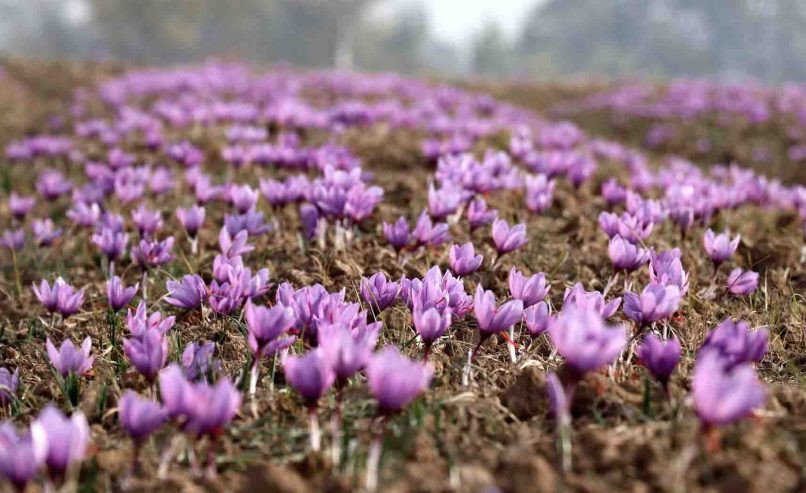
SRINAGAR- Jammu and Kashmir government has approved a prestigious project worth Rs 146 crore to promote the niche crops as unique heritage of the UT, which will be implemented in the next five years.
“The project aims at diversifying and expanding the area of niche crops over an area of 11,100 hectare thus ensuring livelihood security for 111,000 targetted beneficiaries with a revenue realization of Rs. 2,238 Crore” , Additional Chief Secretary (ACS), Agriculture Production Department (APD), Atal Dulloo said.
The initiative will focus on increasing production, improving livelihoods and enhancing market accessibility. This will be achieved through establishment of nurseries and seed villages, infrastructure development, and collaboration with various partners and stakeholders, he added.
Pertinently, Jammu and Kashmir is home to a diverse range of niche crops including Saffron, Kalazeera, Kashmiri Lal Mirch, Peanut, Anardhana, Bhaderwah Rajmash, hill garlic, Mushkbudhji (aromatic rice), Red Rice and Shallot (Pran). These crops are grown on an area of 32,000 hectare, with a total production of 24,000 metric tons making a substantial contribution of Rs. 945 crore to the UT GDP.
The main components of the project included establishment of 5,226 nurseries/seed villages, which will generate 7750 job opportunities for unemployed youth working in the niche sector. Additionally, the project will take up creation of one Mini Spice Park, two Modern Rice Mills and eleven grading and processing units in target clusters, which will be linked with available NABL laboratories and e-trading centers of UT. This will facilitate quality promotion and value addition, leading to profitable accessibility to the market.
To promote these niche crops at the export level, the project shall also undertake tagging of identified niche crops, for which descriptors will be developed for their uniqueness. Likewise, the project will ensure human resource development for capacity building and employment generation. The project is being jointly undertaken by SKUAST Jammu and Kashmir besides the Agriculture and Farmer Welfare Department, Jammu and Kashmir.
Promotion of Niche Crops is one among the 29 projects, which were approved by the Jammu and Kashmir administration after being recommended by the UT Level Apex Committee for holistic development of Agriculture and allied sectors in the UT of J&K. The prestigious committee is headed by Dr Mangala Rai, Former DG ICAR with other luminaries in the field of Agriculture, Planning, Statistics and Administration like Ashok Dalwai, CEO NRAA, Dr. P K Joshi, Secretary, NAAS, Dr. Prabhat Kumar, Horticulture Commissioner MOA and FW, Dr. H S Gupta, Former Director, IARI, Atal Dulloo, Additional Chief Secretary (ACS), Agriculture Production Department (APD), apart from the Vice Chancellors of twin Agriculture Universities of the UT.
There is a long history of cultivating these niche crops in J&K, particularly in heritage sites such as Pampore, Gurez, Padder, Kishtwar, Bhaderwah, Bandipora, Sagam, Tangdar, Ramban and Poonch”, Mr Dulloo said, adding that these crops, including spices, aromatic crops and underutilized horticultural crops, have a significant commercial value and potential to be awarded a GI tag, similar to the tag achieved for Kashmir Saffron.
Currently, spice niche crops are cultivated on 5525 hectare with a total production of 10163 metric tons. Similarly, aromatic crops are cultivated on 250 hectares, with a total production of 750 metric tons. However, heritage underutilized horticultural crops are scattered, with a very low area of 547 hectares, and a production of 81 metric tons. The existing production scenario suggests a great scope for enhancing production to bridge the prevailing market deficit.
Diversification of niche crops in potential areas has been proposed on 11100 hectare of land in various districts of the state. Specifically, saffron will be grown on 290 ha in Kupwara, Baramulla, Ganderbal, Bandipora, Kulgam, Shopian, Anantnag, Doda, Ramban, Poonch, Rajouri, Reasi and Udhampur, Kalazeera on 300 ha in Bandipora, Kishtwar and Pulwama, Kashmiri Lal Mirch on 1000 ha’s in Anantnag, Kulgam and Kupwara, Peanut on 410 ha in Doda, Rajouri, Poonch and Kishtwar, Bhaderwah Rajmash on 6000 ha in Kishtwar, Kathua, Poonch, Rajouri and Doda, Hill Garlic on 2000 ha in Jammu, Samba, Kathua and Udhampur, Mushkbudji on 600 ha’s in Anantnag, Kulgam and Kupwara besides Red Rice on 500 ha in District Anantnag, Baramulla, Kupwara and Budgam districts.
To meet the emerging market demand for niche crops as functional food, there is an immediate need to extend the area of cultivation in similar agro-ecological conditions in J&K, either as a sole crop or as an intercrop. The introduction of niche value chains in prevailing cropping systems will not only increase production but will also meet the goal of raising farmers income substantially, ensuring livelihood security and stability. The expanded area of cultivation will include Kupwara, Baramulla, Ganderbal, Bandipora, Kulgam, Budgam, Pulwama, Shopian, Anantnag, Doda, Ramban, Poonch, Rajouri, Udhampur, Reasi, Samba, Kathua and Kishtwar.
One of the key challenges in expanding the area of cultivation is lack of availability of quality planting material. The project aims to address this challenge through establishment of 5182 registered nurseries on 408 ha and 44 seed villages over an area of 212 ha particularly in heritage sites such as Pampore, Gurez, Padder, Kishtwar, Baderwah, Bandipora, Sagam, Tangdar, Ramban and Poonch. The cumulative output from the nurseries/seed villages shall include 2159 MT of quality planting material, 40000 plants and 10 crore seedlings. The outcome of the project will serve as a pilot module for area expansion for production enhancement of high value crops as a long-term strategy in UT of J&K.
Follow this link to join our WhatsApp group: Join Now
Be Part of Quality Journalism |
Quality journalism takes a lot of time, money and hard work to produce and despite all the hardships we still do it. Our reporters and editors are working overtime in Kashmir and beyond to cover what you care about, break big stories, and expose injustices that can change lives. Today more people are reading Kashmir Observer than ever, but only a handful are paying while advertising revenues are falling fast. |
| ACT NOW |
| MONTHLY | Rs 100 | |
| YEARLY | Rs 1000 | |
| LIFETIME | Rs 10000 | |











